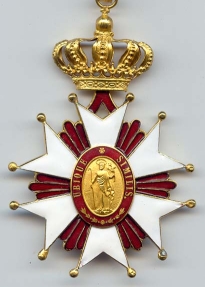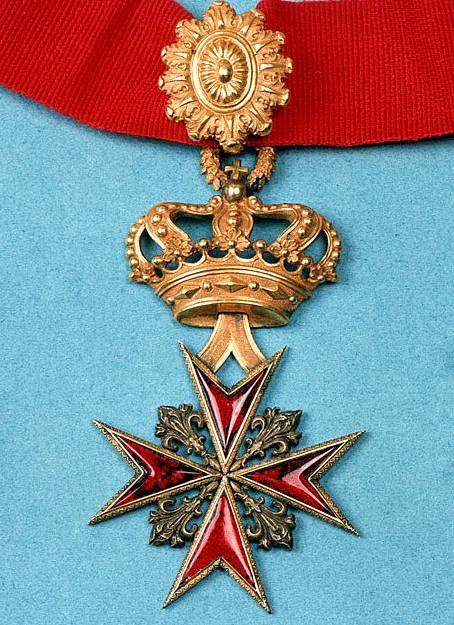|
Vincenzo Antinori
Vincenzo Antinori (1792–1865) was a science administrator in Italy. From 1829 to 1859, Antinori was director of the Regal Museum of Physics and Natural History in Florence where he worked with Leopoldo Nobili on electromagnetic induction. He had originally attracted Nobili to Florence to teach physics, as he had Giovanni Battista Amici to teach astronomy. He was one of the promoters of the Congress of Italian Scientists in Pisa in 1839 and in Florence in 1841 and was responsible for bringing permanence, order and security to the Italian legacy of meteorological data by founding the Italian Meteorological Archive. Antinori was a member of the Accademia della Crusca and wrote many entries for the Crusca dictionary on scientific topics. He had a particular interest in preserving and interpreting documents and artefacts from the work of Galileo Galilei and his followers. Bibliografía: "Antonio Meucci e la città di Firenze. Tra scienza, tecnica e ingegneria". Editado por Angot ... [...More Info...] [...Related Items...] OR: [Wikipedia] [Google] [Baidu] |
Science
Science is a systematic endeavor that builds and organizes knowledge in the form of testable explanations and predictions about the universe. Science may be as old as the human species, and some of the earliest archeological evidence for scientific reasoning is tens of thousands of years old. The earliest written records in the history of science come from Ancient Egypt and Mesopotamia in around 3000 to 1200 BCE. Their contributions to mathematics, astronomy, and medicine entered and shaped Greek natural philosophy of classical antiquity, whereby formal attempts were made to provide explanations of events in the physical world based on natural causes. After the fall of the Western Roman Empire, knowledge of Greek conceptions of the world deteriorated in Western Europe during the early centuries (400 to 1000 CE) of the Middle Ages, but was preserved in the Muslim world during the Islamic Golden Age and later by the efforts of Byzantine Greek scholars who brought Greek ... [...More Info...] [...Related Items...] OR: [Wikipedia] [Google] [Baidu] |
Chamberlains Of The Gran Duke Of Tuscany
Chamberlain may refer to: Profession *Chamberlain (office), the officer in charge of managing the household of a sovereign or other noble figure People *Chamberlain (surname) **Houston Stewart Chamberlain (1855–1927), German-British philosopher and racialist writer **Joshua Chamberlain (1828–1914), Brigadier General of American Civil War and Governor of Maine **Neville Chamberlain (1869–1940), British Prime Minister at the outbreak of World War II **Wilt Chamberlain (1936–1999), American basketball player Places *Chamberlains, Newfoundland and Labrador, Canada *Chamberlain, Ontario, Canada *Chamberlain, Saskatchewan, Canada *Chamberlain Township, Brule County, South Dakota, a township **Chamberlain, South Dakota, United States, a city *Chamberlain, Uruguay *Chamberlain Basin, Custer County, Idaho *Chamberlain Square in Birmingham, England *D.S. Chamberlain Building, listed on the National Register of Historic Places in Polk County, Iowa Arts, entertainment, and medi ... [...More Info...] [...Related Items...] OR: [Wikipedia] [Google] [Baidu] |
1865 Deaths
Events January–March * January 4 – The New York Stock Exchange opens its first permanent headquarters at 10-12 Broad near Wall Street, in New York City. * January 13 – American Civil War : Second Battle of Fort Fisher: United States forces launch a major amphibious assault against the last seaport held by the Confederates, Fort Fisher, North Carolina. * January 15 – American Civil War: United States forces capture Fort Fisher. * January 31 ** The Thirteenth Amendment to the United States Constitution (conditional prohibition of slavery and involuntary servitude) passes narrowly, in the House of Representatives. ** American Civil War: Confederate General Robert E. Lee becomes general-in-chief. * February ** American Civil War: Columbia, South Carolina burns, as Confederate forces flee from advancing Union forces. * February 3 – American Civil War : Hampton Roads Conference: Union and Confederate leaders discuss peace terms. * February 8 & ... [...More Info...] [...Related Items...] OR: [Wikipedia] [Google] [Baidu] |
1792 Births
Year 179 ( CLXXIX) was a common year starting on Thursday (link will display the full calendar) of the Julian calendar. At the time, it was known as the Year of the Consulship of Aurelius and Veru (or, less frequently, year 932 ''Ab urbe condita''). The denomination 179 for this year has been used since the early medieval period, when the Anno Domini calendar era became the prevalent method in Europe for naming years. Events By place Roman empire * The Roman fort Castra Regina ("fortress by the Regen river") is built at Regensburg, on the right bank of the Danube in Germany. * Roman legionaries of Legio II ''Adiutrix'' engrave on the rock of the Trenčín Castle (Slovakia) the name of the town ''Laugaritio'', marking the northernmost point of Roman presence in that part of Europe. * Marcus Aurelius drives the Marcomanni over the Danube and reinforces the border. To repopulate and rebuild a devastated Pannonia, Rome allows the first German colonists to enter territory co ... [...More Info...] [...Related Items...] OR: [Wikipedia] [Google] [Baidu] |
19th-century Italian Scientists
The 19th (nineteenth) century began on 1 January 1801 ( MDCCCI), and ended on 31 December 1900 ( MCM). The 19th century was the ninth century of the 2nd millennium. The 19th century was characterized by vast social upheaval. Slavery was abolished in much of Europe and the Americas. The First Industrial Revolution, though it began in the late 18th century, expanding beyond its British homeland for the first time during this century, particularly remaking the economies and societies of the Low Countries, the Rhineland, Northern Italy, and the Northeastern United States. A few decades later, the Second Industrial Revolution led to ever more massive urbanization and much higher levels of productivity, profit, and prosperity, a pattern that continued into the 20th century. The Islamic gunpowder empires fell into decline and European imperialism brought much of South Asia, Southeast Asia, and almost all of Africa under colonial rule. It was also marked by the collapse of the large S ... [...More Info...] [...Related Items...] OR: [Wikipedia] [Google] [Baidu] |
Leopold II, Grand Duke Of Tuscany
Leopold II( it, Leopoldo Giovanni Giuseppe Francesco Ferdinando Carlo, german: Leopold Johann Joseph Franz Ferdinand Karl, English: ''Leopold John Joseph Francis Ferdinand Charles''. (3 October 1797 – 29 January 1870) was Grand Duke of Tuscany from 1824 to 1859. He married twice; first to Maria Anna of Saxony, and after her death in 1832, to Maria Antonia of the Two-Sicilies. By the latter, he begat his eventual successor, Ferdinand. Leopold was recognised contemporarily as a liberal monarch, authorising the Tuscan Constitution of 1848, and allowing a degree of press freedom. The Grand Duke was deposed briefly by a provisional government in 1849, only to be restored the same year with the assistance of Austrian troops, who occupied the state until 1855. Leopold attempted a policy of neutrality with regard to the Second Italian War of Independence, but was expelled by a bloodless coup on 27 April 1859, just before the beginning of the war. The Grand Ducal family left for B ... [...More Info...] [...Related Items...] OR: [Wikipedia] [Google] [Baidu] |
Order Of Saint Joseph
The Order of Saint Joseph was instituted on 9 March 1807 by Ferdinand III, Grand Duke of Tuscany during his reign as Grand Duke of Würzburg. It was transformed into a Tuscan Roman Catholic Dynastic Order in 1817. The constitution of the Order was promulgated in March 1817, with amendments in August 1817. The order was divided into civil and military categories but these are now defunct. It is given to reward services towards Tuscan culture and civilisation and to the Grand Ducal House as a whole. The Order is divided into three levels: * Knights Grand Cross, numbering thirty * Commander, numbering sixty * Knights, numbering one hundred and fifty These numbers excluded Sovereigns, Heads of State, and Princes of the Grand Ducal House and other Royal Houses, Cardinals of the Holy Roman Church and Tuscan Metropolitan Archbishops. All had to be Catholics. The number of women members cannot exceed fifty, excluding Princesses of the Grand Ducal and other Royal Houses, wives of Heads ... [...More Info...] [...Related Items...] OR: [Wikipedia] [Google] [Baidu] |
Grand Duchy Of Tuscany
The Grand Duchy of Tuscany ( it, Granducato di Toscana; la, Magnus Ducatus Etruriae) was an Italian monarchy that existed, with interruptions, from 1569 to 1859, replacing the Republic of Florence. The grand duchy's capital was Florence. In the 19th century the population of the Grand Duchy was about 1,815,000 inhabitants. Having brought nearly all Tuscany under his control after conquering the Republic of Siena, Cosimo I de' Medici, was elevated by a papal bull of Pope Pius V to Grand Duke of Tuscany on August 27, 1569. The Grand Duchy was ruled by the House of Medici until the extinction of its senior branch in 1737. While not as internationally renowned as the old republic, the grand duchy thrived under the Medici and it bore witness to unprecedented economic and military success under Cosimo I and his sons, until the reign of Ferdinando II, which saw the beginning of the state's long economic decline. It peaked under Cosimo III. Francis Stephen of Lorraine, a cognatic de ... [...More Info...] [...Related Items...] OR: [Wikipedia] [Google] [Baidu] |
Order Of Saint Stephen
The Order of Saint Stephen (Official: Sacro Militare Ordine di Santo Stefano Papa e Martire, "Holy Military Order of St. Stephen Pope and Martyr") is a Roman Catholic Tuscan dynastic military order founded in 1561. The order was created by Cosimo I de' Medici, first Grand Duke of Tuscany. The last member of the Medici dynasty to be a leader of the order was Gian Gastone de Medici in 1737. The order was permanently abolished in 1859 by the annexation of Tuscany to the Kingdom of Sardinia. The former Kingdom of Italy and the current Italian Republic also did not recognize the order as a legal entity but tolerates it as a private body. History The order was founded by Cosimo I de' Medici, first Grand Duke of Tuscany, with the approbation of Pope Pius IV on 1 October 1561. The rule chosen was that of the Benedictine Order. The first grand master was Cosimo himself and he was followed in that role by his successors as grand duke. The dedication to the martyred Pope Stephen ... [...More Info...] [...Related Items...] OR: [Wikipedia] [Google] [Baidu] |





